|
|
 |
|
|
 |
| Buyers Guide |
| About this Guide |
Please use this buyers guide as just
that - a guide. It is not the definitive work on all 164 QV or Q4 problems or known
issues, but MAY help you in selecting a car that you are happy to own. It has been
compiled using input from owners and those who have had direct experience of this
particular model of car. Always remember that the condition of a car reflects the
way it has been treated, and these cars DO inspire some spirited driving, so beware.
Although it has been compiled for the Cloverleaf (Cloverleaf, S, QV & Q4) models, many of the comments relate to other variants as well. A word on nomenclature (naming conventions). In the UK, the model was designated as 'Cloverleaf'. In many other countries, it was 'Quadrifoglio Verde' which is Italian for Green Cloverleaf, hence 'QV'. The 12v models in the United States were designated 'S', while the 24v were 'QV'. The Q4 model, a 4x4 version, only available in left hand drive (Europe), is always referred to as 'Q4'. So, if someone talks about their 'Leaf, it usually means a UK Cloverleaf, while a 'QV' or 'S' suggests a USA spec model. General Comments: Service History: An absolute must. Regular maintenance is needed with any car, and documentary evidence is the only sure way to form an opinion. OK, if someone says they have had it serviced regularly, but cannot supply the documentation, ask where it was done and contact the garage or service shop. Most are happy to help if you are considerate and hint that there might be some work in it for them! If they cannot come up with a reasonable story, treat suspiciously. MOT certificates (or the equivalent outside the UK) are another good guide to consistency and mileage usage. Although these cars are relatively cheap to buy now (in terms of bangs per buck) they are not cheap to run, and anyone thinking they are is deluding themselves. To service and maintain it yourself, I think you would have to be a pretty smart mechanic, with access to a wide range of good tools. However, don't let that put you off ownership - there are a number of specialist garages and individuals who will help you, and most understand that ripping you off will not encourage you to go back. So, be prepared for expense. Apologies to dealers, but in my experience, they have no interest in these cars, and do not provide an economic option. You may have to use a dealer for parts supply - be prepared to pay up front and wait for delivery. Even simple things like radiator hoses appear to be on special order only. As far as running costs go, insurance is top of the tree in terms of risk (not a surprise). Use a specialist broker - Chris Knott in the UK is a good place to start. Fuel consumption averages around 25-30mpg (Imperial, not US) depending upon how you drive. 30+ is easy on long trips, at a constant 70mph or so. Parts supply is beginning to become a problem. Most parts are available, but they won't be for much longer (written May 2004). Last year AR had a price reduction on many parts, a sure sign they are trying to move them out of stock. Alfa Romeo Owners Clubs events are good hunting grounds for parts, as well as autojumbles and suchlike. I'll leave out all the obvious checks - they are mainly common sense anyway, and if you're at all suspicious, walk away. So, to business..... |
Engine - General
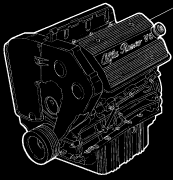 |
The 164 Cloverleaf comes in two basic flavours - 12
valve and 24 valve.
Check that the cam belt has been changed at recommended
intervals, and that the tensioner has been replaced at each change as well. Recommended
interval is 30k miles - don't leave it ANY later. A rebuild will cost you thousands
if you are unlucky, so take no chances. A new engine (assuming you can get hold of
one) is around five grand, so a few hundred spent on a belt change is money well invested.
Apart from the above, engine problems are rare and
appear to be limited to the fuel delivery/ignition area. There is a coil for each
plug, buried under the cam covers. Changing the plugs is a bigger job than you might
think. Ensure that the fuel filter is changed regularly. Fuel leaks in the small bore
hoses which deliver fuel to the injector rails can leak at the clips, or perish and
split. Smell of petrol in the car is a dead giveaway for this. Petrol fumes can also
originate from around the top of the tank, where there are various openings and tubes.
Silicone sealant can cure most of these problems, but ALWAYS TAKE CARE WITH PETROL
- NO NAKED LIGHTS. Burns are very painful, and sometimes fatal.
|
Transmission |
No known problems here, transmission is pretty good, and clutch wear seems reasonable
with careful driving. There are reports of early models having unreasonable gearbox
wear (Fiat unit, I believe) that causes whining on engine overrun. Suspect bearing
problems if you can hear this.
|
Cooling System
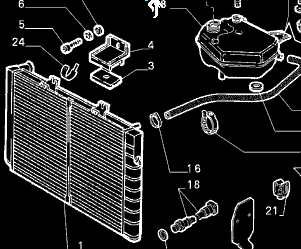 |
Ah, the mysteries of the 164 cooling system. Can be a problem area. Check the condition of the radiator carefully - originals just crumble away leaving the inner core, which is very poor at conducting heat. New ones cost about 150. Often difficult to see the rad as the A/C matrix is in the way. The thermostat may also fail or stick. Replacement is tricky due to the location. Fan troubles are most likely to be problems with the various electrical circuits or radiator sender. The system has a two speed cooling fan, the slow fan speed being controlled via the use of a resistor in the circuit. A second circuit that bypasses the resistor is used for high speed operation. When the aircon is running, the slow speed fan should come on to cool the a/c matrix. Run the aircon at coldest. When the aircon matrix heats up, check that the slow speed fan starts running. The resistor usually fails at some point. It is located in the fan/radiator shroud assembly, so it's in the hot air flow, and gets hotter still during operation. Easy to replace or relocate for longer life.
Without the aircon on, run the car until hot and check that the electric cooling fan
comes on at about 90 on the gauge. If it goes up to 110 or so before cutting in, the
slow speed fan is not operating properly. It's not uncommon for faulty senders, the
gauge, or dirty connections to give false readings.
|
Brakes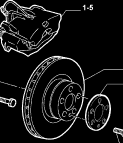 |
164 brakes in general were never really up to the job. QV and Q4 use ventilated discs front and rear, that are OK, but not outstanding. Discs may be worn sooner that you might think. Vibration through the pedal can indicate warped discs. If modifications have been made, ensure they have been properly carried out - if in doubt, get an independent opinion from an expert. Generally though, not too much trouble, just not up to the job for the cars performance. Better pads are a good option. |
Steering & Suspension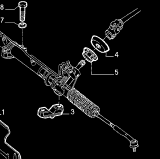 |
As the years passed, the torque steer that plagued early 164's was reduced to an acceptable
level. The steering works nicely, is well weighted, but the car has a poor turning
circle. |
Aircon and Heating/Ventilation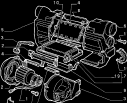 |
The most publicized fault on early cars, was the air distribution drums in the heater system. The drums are moved by way of gears on the end of the shafts, and stepping motors. Air distribution is changed by the movement and position of the drums. These gears were originally made of a plastic that stripped the teeth after a while, making the system impossible to use, with the distribution stuck in one mode. Whilst not a difficult problem to diagnose, the fix was a nightmare, as it entailed removal of most of the dashboard, which was high in labour cost. Various different methods have been suggested to get around this, there is even a video available I understand, to help you do it. So, check the operation of the heater carefully. Listen for any ticking sound. This indicates the fault. It is possible to buy replacement metal gears from a place in Australia I believe. Later cars do not tend to suffer from this problem.
Like most similar systems, the aircon can fail for a number of reasons. Check the
operation of the clutch on the compressor by running the car at idle, with the system
set to economy. Then switch to auto. You should hear the clutch work and the compressor
start. If it doesn't, it may not be as bad as it appears, but beware. If the compressor
is running and the system does not deliver very cold air, the system may have a leak
and need topping up. The aircon matrix in front of the bonnet should be hot if it's
working correctly. |
| Electrical Systems |
This is probably the most troublesome aspect of the
car. The number of gadgets and gizmos mean that there is plenty to go wrong. Some
faults appear to be quite bizarre, with no obvious reason why they are happening.
In short, if it matters to you, check everything works correctly. If you can, check
out before you test drive, and after, as some faults have a habit of 'coming and going'.
The weather can also be an influencing factor, with damp conditions causing shorts
or other failures. If the car has all systems working perfectly, you are on hallowed
ground. Alarm System: The weakest part of this system is the key fob, which self destructs without warning. A Phillips system uses a rolling code, and it cannot be cloned. If you find someone who can sort this out (for the fitted Phillips system) I would be very interested. The alternative is to pull the fuse and forget the alarm system, or have a new one fitted. Headlights are expensive to replace - better to get some plastic protectors (but getting difficult to find). Heated seat elements also fail regularly (often just poor connections). The general quality of the plastic parts associated with the electrical system is not very good, being brittle and prone to breakage. Bad earths and brittle wiring contribute to lots of faults. |
Bodywork and other things...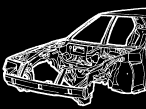 |
Generally, this is very good and unlikely to be a problem.
The bottom of the shell was galvanized, so there are unlikely to be serious issues
with the floor pan and door bottoms. The front subframe and rear cross member are
the most likely places where corrosion will take hold. The rear cross member is cheap
to replace in terms of part costs, but there will be some labour involved. If the
front subframe needs doing, expect a hefty bill.
There are a few other points to check. The rear wheel arches seem prone to rust, down near where the rear doors fit. Screens, front and rear, sometimes leak, leading to water under the mats (nasty!). This can be cured with a careful application of clear silicone sealant around the gaps and edges - cheaper than new glass. I've also heard of sun roof's with a similar problem. This will require new seals though. The skirts and door trim are quite durable. Panel fit was never a success on these cars, so don't be put off by gaps etc, it doesn't mean too much. Wing mirror mounts may corrode and loose their paint finish - this happens to other 164 models, not just 'Leafs. Beware, there is NO manual bonnet release, as with other, older, Alfa's. If the bonnet release cable snaps, you will need the help of a mechanic to get it open again (I did, anyway). |
| Conclusion |
I can only offer a conclusion based upon my experiences, and those shared with me through this register, and various other sources. Like many similar models from other European makers, this is a complicated piece of machinery. If treated well, serviced regularly and used with some thought (rather than thrashed all the time) it will last for many years, and well over 200,000 miles. The old caveat of 'buyer beware' still holds good. From personal experience, buying from a dealer is no guarantee of quality, what ever their marketing may suggest. If a car is offered with a third party warranty, ensure the warranty actually exists. I have learned from bitter experience, where a 'salesman' at a well respected main Alfa dealer (some years ago - the dealer does not exist anymore) sold me a car with a third party warranty. When the car required major work under the warranty, it turned out that the salesman had pocketed the warranty fee, and had not actually purchased warranty cover. Needless to say, the dealer was obliged to do the work, not just for me but for a number of other people, and eventually went out of business as a consequence. So, buying from a private owner, who may be an enthusiast (it's easy to tell!) is just as 'safe'. That said, I'm sure there are many excellent dealers and traders who will treat you as a valued customer, and ensure the car you are buying is 'as advertised' in the best sense of the term. In summary then: Do your homework, check the documentation, take a proper test drive (not just a run around the block), Examine the car as if you were washing it - mentally go over each panel, its amazing what you notice when you do this. Obviously, do the usual things you would do with any car - oil, water etc. Good Luck, and Good Hunting If you would like to contribute to this section, please go to the visitors book page, and send me your email address. I will contact you. Thanks |